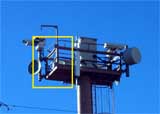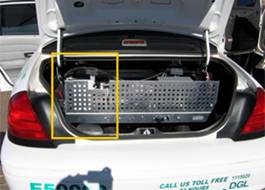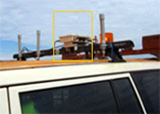|
||
     Homeland Defense Departments, Security Agencies, Governments and other organizations require higher levels of perimeter security today than ever before. Two key elements of modern security strategy include video surveillance and extension of wireless data access for security personnel. But extending these services along borders, perimeters, in wilderness areas or congested downtowns often requires many (node-to-node) hops. These demanding military and security wireless applications require secure, high-speed connectivity for data, video and voice. Patented and patent-pending technology utilizes multiple backhaul radios to provide near-instantaneous network set-up, node mobility at high speeds, high bandwidth, and minimal delay and jitter. Border and perimeter security environments demand high performance over extended distances for date, voice and surveillance and tactical video. In most cases, wired or fiber connectivity is unavailable, so the network must be delivered wireless over many hops (node to node connections). Meshdynamics' patented and patent pending third-generation wireless mesh architecture delivers bandwidth with minimal delay and jitter over many hops. In addition, the Meshdynamics network functions as a Layer 2 switch infrastructure, transparent to a wide variety of sensor and video streams. In a successful long-term pilot network across the Arizona-Mexico border, Meshdynamics nodes are providing connectivity for a variety of security applications to mobile border security forces. Node-to-node distances reach up to 14 miles. News Article Meshdynamics products are especially well suited for large scale deployments where voice and video quality is paramount. Competing products failed in these challenging video surveillance applications, due to unacceptable latency and jitter as deployments scaled (e.g. more hops, more cameras, mobile transmissions). Based on competitive bids, the Department of Homeland Security (DHS) selected Meshdynamics mesh nodes to provide remote video surveillance for stationary and vehicle mounted cameras along the US national border. UK, Israeli and Canadian defense agencies also selected Meshdynamics for wireless video surveillance applications. IP cameras, connected to the MD4250 mesh nodes transmitting high resolution real time video over the mesh network to the base station video monitors. Other cited key advantages: Managed Latency and Jitter: Earlier-generation mesh networking products perform poorly in multi-hop (node-to-node relay) environments. Meshdynamics' patented low latency multiple radio wireless mesh technology preserves high performance [over multiple hops] that's been available only in wired networks until today. US Defense Agencies has validated these claims. Meshdynamics EffistreamTM: :For Glitch Free Real Time Video Transmissions. Meshdynamics Network Management System (NMS) provides users the ability to ensure real time streams (e.g. VOIP and Video) are handled differently along the mesh. The result: glitch free real-time video over mesh networks. Jitter and Latency Easy Extensions to Network Tree: Meshdynamics 4-radio slot products enable multiple radio backhauls to fork from one mesh node The dual downlink models MD4452 and MD44454 support 2X and 4X Backhaul throughput back to the control station, 1. Video over Mesh Networks. slides from Video Tutorial. Number of cameras, node placements etc. 2. Meshdynamics "On Target" for Military Vehicle Video Armored vehicles with 30 FPS video cameras 3. Border Security Applications and Solutions: network deployments along Mexico-Arizona border. 4. Distributed Mesh System Supports Public Safety Communications: News Article on 4.9 GHz radio support. 5. High Speed Mobility Test -1 Glitch free video transmission over 4 hops, traveling at 50+ mph. 6. High Speed Mobility Test -2 Video feed from one vehicle to another |
||